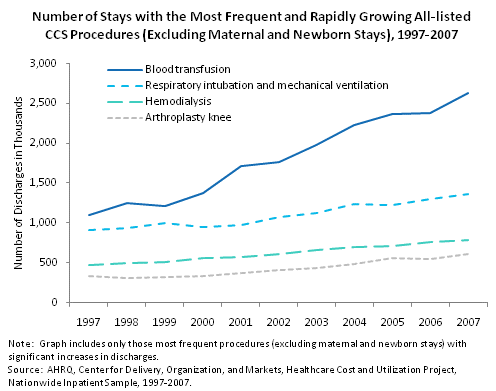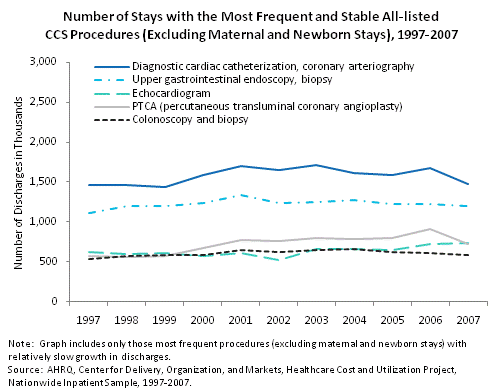TABLE OF CONTENTS
HIGHLIGHTS
INTRODUCTION
HCUP PARTNERS
1. OVERVIEW
2. DIAGNOSES
3. PROCEDURES
4. COSTS
5. PAYERS
SOURCES/METHODS
DEFINITIONS
FOR MORE INFO
ACKNOWLEDGMENTS
CITATION
FACTS & FIGURES 2007 PDF
|
EXHIBIT 3.1 Most Frequent All-listed Procedures PDF
Number, Percent Distribution, Rank, and Growth of Discharges for the Most Frequent All-listed Inpatient Hospital Procedures, 1997 and 2007
| ALL-LISTED CCS PROCEDURES |
NUMBER OF STAYS WITH THE PROCEDURE IN THOUSANDS |
PERCENT OF DISCHARGES WITH THE PROCEDURE |
RANK |
CUMULATIVE GROWTH |
| 1997 |
2007 |
1997 |
2007 |
1997 |
2007 |
1997-2007 |
| All discharges (with and without procedures) |
34,679 |
39,542 |
|
|
|
|
14% |
| All discharges with any procedure |
21,257 |
25,286 |
100.0% |
100.0% |
|
|
19 |
| Percent of all discharges with a procedure |
61% |
64% |
|
|
|
|
|
| Maternal and newborn procedures |
8,233 |
9,760 |
38.7 |
38.6 |
|
|
19 |
| Prophylactic vaccinations and inoculations |
567 |
1,638 |
3.0 |
6.5 |
14 |
2 |
189 |
| Cesarean section (C-section) |
800 |
1,482 |
4.0 |
5.9 |
9 |
3 |
85 |
| Repair of obstetric laceration |
1,137 |
1,448 |
5.0 |
5.7 |
3 |
5 |
27 |
| Circumcision |
1,164 |
1,302‡ |
5.0 |
5.2 |
2 |
7 |
12 |
| Fetal monitoring |
1,002 |
1,257‡ |
5.0 |
5.0 |
6 |
8 |
25 |
| Artificial rupture of membranes to assist delivery |
747 |
1,169 |
4.0 |
4.6 |
10 |
10 |
56 |
| Episiotomy (surgical incision into the perineum and vagina to prevent traumatic tearing during delivery) |
866 |
380 |
4.0 |
1.5 |
8 |
26 |
-56 |
| All other procedures |
13,024 |
15,525 |
61.3 |
61.4 |
|
|
19 |
| Blood transfusion |
1,097 |
2,629 |
5.0 |
10.4 |
5 |
1 |
140 |
| Diagnostic cardiac catheterization, coronary arteriography (diagnostic procedure to explore the functioning of the heart) |
1,461 |
1,471‡ |
7.0 |
5.8 |
1 |
4 |
1 |
| Respiratory intubation and mechanical ventilation |
919 |
1,359 |
4.0 |
5.4 |
7 |
6 |
48 |
| Upper gastrointestinal endoscopy (procedure to view and biopsy the esophagus, stomach and first portion of intestine through a lighted tube) |
1,105 |
1,191 |
5.0 |
4.7 |
4 |
9 |
8 |
| Hemodialysis (dialysis, cleaning the blood by means of a machine or filter to compensate for poor kidney function) |
473 |
786 |
2.2 |
3.1 |
17 |
11 |
66 |
| Echocardiogram (diagnostic ultrasound of heart) |
632 |
739‡ |
3.0 |
2.9 |
11 |
12 |
17 |
| PTCA (percutaneous transluminal coronary angioplasty, procedure involving use of a balloon-tipped catheter to enlarge a narrowed artery) |
581 |
722 |
2.7 |
2.9 |
13 |
13 |
24 |
| Arthroplasty knee |
329 |
611 |
1.5 |
2.4 |
32 |
14 |
86 |
| Colonoscopy and biopsy |
531 |
582 |
2.5 |
2.3 |
16 |
15 |
10 |
‡ 2007 discharges are not statistically different from 1997 discharges at p‹0.05.
Source: AHRQ, Center for Delivery, Organization, and Markets, Healthcare Cost and Utilization Project, Nationwide Inpatient Sample, 1997 and 2007. |
During almost two out of every three hospital stays in 2007, at least one procedure was performed, and this proportion increased slightly since 1997. The number of discharges with procedures increased from 21.3 million in 1997 to 25.3 million in 2007, a 19-percent increase.
- The top all-listed procedures performed in 2007 were performed in 2 to 10 percent of all stays. In many stays, more than one procedure was performed.
- Blood transfusions occurred in one out of every 10 hospital stays that included a procedure and were the most frequently performed procedures in 2007.
- While many of the top 15 most frequent procedures in 2007 were also on the list in 1997, there were some notable exceptions:
- Vaccinations were added to the list of top procedures, rising in rank from 14th in 1997 to 2nd in 2007. These vaccinations were overwhelmingly hepatitis B immunizations for newborns.
- Episiotomy fell from the list of top procedures, dropping in rank from 8th in 1997 to 26th in 2007.
- Discharges with arthroplasty of the knee procedures have steadily risen from 0.3 million in 1997 to 0.6 million in 2007, rising in rank from the 32nd to the 14th most common procedure.
- Hemodialysis and colonoscopy and biopsy have risen over the 1997-2007 period and are now ranked in the top 15 procedures performed in hospitals.
- C-section was the most frequent major operating room procedure—performed on 1.5 million women in 2007.

(text version)
Six of the top procedures in 2007 were associated with giving birth or newborns.
- Maternal stays:
- Growth in C-sections, up 85 percent between 1997 and 2007, outpaced increases in most other frequently performed maternal procedures.
- Hospital stays with artificial rupture of membrane to assist delivery increased by 56 percent.
- Exhibiting the opposite trend, hospital stays in which episiotomies were performed declined at a faster rate than any of the most frequent procedures—by 56 percent from 1997 to 2007. Episiotomies are performed to assist or speed delivery and/or prevent trauma to the mother. They were performed fairly routinely, but lack of clinical evidence of benefits and some indication of increased injury from the procedure has led to decline in the use of the procedure.6
- Possibly as a result of the decrease in episiotomies, repair of current obstetric laceration increased by 27 percent, occurring in 310,000 more discharges in 2007 than in 1997. This compares with a decline of 486,000 discharges in which episiotomies were performed over the same period.
- Newborn stays:
- Vaccinations were the second most frequent procedure for all discharge types as well as the fastest growing of the most common procedures performed during a newborn hospital stay. This procedure was performed during 1.6 million stays in 2007 and increased 189 percent between 1997 and 2007.
- There has been little change in the number of discharges for circumcision or fetal monitoring since 1997.

(text version)
Other frequent procedures that were not related to giving birth or being born also grew rapidly.
- Discharges with blood transfusions more than doubled between 1997 and 2007. There were 1.1 million stays with this procedure in 1997 and 2.6 million in 2007, for a cumulative growth of 140 percent.
- Discharges for respiratory intubation rose steadily, increasing 48 percent over the 1997-2007 period.
- From 1997 to 2007, arthroplasty of the knee increased by 86 percent and hemodialysis procedures by 66 percent.

(text version)
Some of the most frequent non-maternal, non-newborn procedures increased more slowly between 1997 and 2007.
- Three of the five frequent inpatient procedures with slower growth between 1997 and 2007 were cardiac procedures.
- Procedures for PTCA (percutaneous transluminal coronary angioplasty—a procedure involving the use of a balloon-tipped catheter to enlarge a narrowed artery) grew 56 percent from 1997-2006. Between 2006 and 2007, however, there was a 20-percent decline in discharges with this procedure.
- After growing 17 percent from 1997-2003, inpatient discharges with diagnostic catheterization and coronary arteriography declined 14 percent from 2003-2007, resulting in almost no change (1 percent) from 1997 to 2007.
- The use of inpatient echocardiograms changed little between 1997 and 2007.
- Inpatient upper gastrointestinal endoscopy and biopsy procedures increased 8 percent between 1997 and 2007. This overall growth masks a 20-percent increase in the use of this procedure between 1997 and 2001, followed by a decrease between 2001 and 2007 of 11 percent.
- Inpatient colonoscopy and biopsy grew slowly—only 10 percent over the period.
6Hartman K, Viswanathan M, Palmieri R, Gartlehner G, Thorp J, Lohr K. Outcomes of Routine Episiotomy: A Systematic Review. JAMA 293:2141-2148; 2005.
|